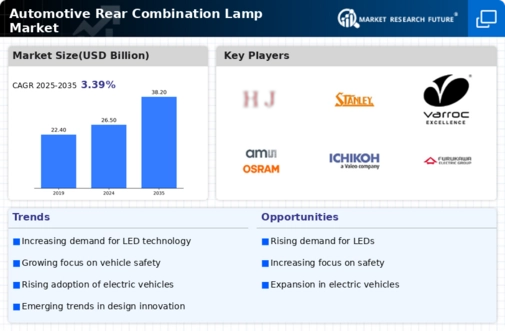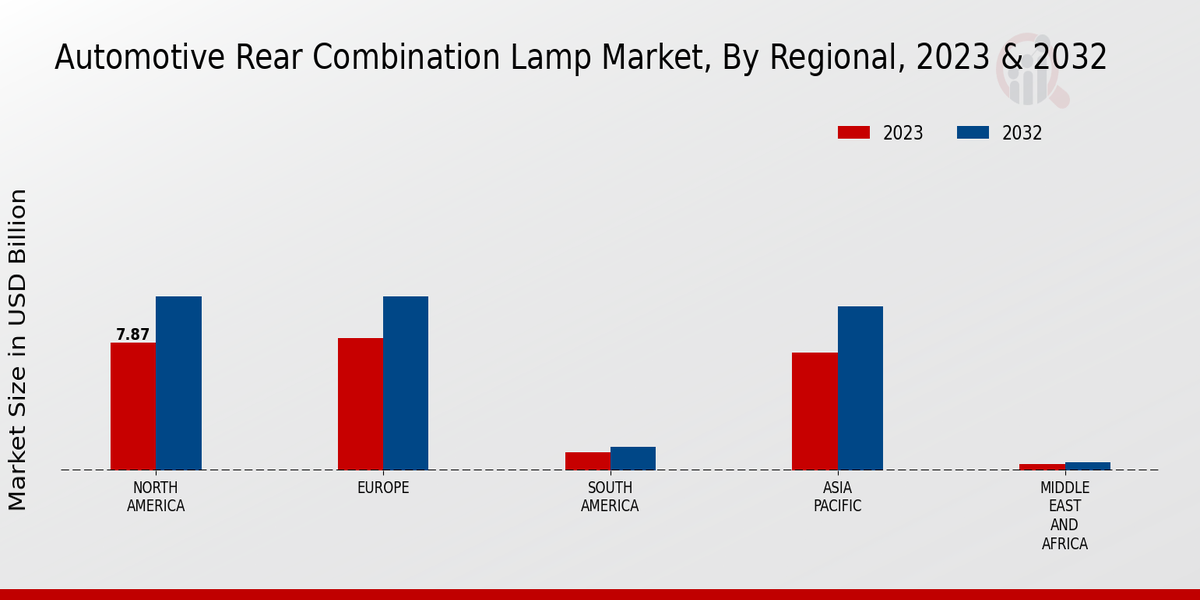Market Growth Projections
The Global Automotive Rear Combination Lamp Market Industry is projected to experience a compound annual growth rate (CAGR) of 3.39% from 2025 to 2035. This growth trajectory indicates a robust demand for rear combination lamps as the automotive sector evolves. The market is expected to reach 38.2 USD Billion by 2035, reflecting the increasing emphasis on safety and technological advancements in lighting systems. As manufacturers continue to innovate and adapt to changing consumer preferences, the market is likely to expand, driven by both regulatory requirements and consumer demand for enhanced vehicle safety features.
Increasing Vehicle Production
The Global Automotive Rear Combination Lamp Market Industry is experiencing growth driven by the rising production of vehicles worldwide. In 2024, the market is projected to reach 26.5 USD Billion, reflecting the increasing demand for automobiles across various segments. As manufacturers ramp up production to meet consumer needs, the requirement for rear combination lamps, which enhance vehicle safety and visibility, becomes paramount. This trend is likely to continue, as the automotive sector anticipates a steady increase in vehicle output, further solidifying the market's position. The projected growth in vehicle production is expected to support the expansion of the Global Automotive Rear Combination Lamp Market Industry.
Growing Awareness of Road Safety
Increasing awareness of road safety among consumers is a pivotal driver for the Global Automotive Rear Combination Lamp Market Industry. As accidents caused by poor visibility remain a concern, consumers are becoming more discerning about vehicle safety features, including lighting systems. This heightened awareness is prompting manufacturers to prioritize the development of advanced rear combination lamps that enhance visibility and safety. The market is projected to grow as consumers increasingly demand vehicles equipped with superior lighting solutions. This trend underscores the importance of safety in automotive design and is likely to sustain the growth trajectory of the Global Automotive Rear Combination Lamp Market Industry.
Technological Advancements in Lighting
Technological innovations in lighting systems are significantly influencing the Global Automotive Rear Combination Lamp Market Industry. The introduction of LED and adaptive lighting technologies enhances the performance and energy efficiency of rear combination lamps. These advancements not only improve visibility but also contribute to the overall aesthetic appeal of vehicles. As manufacturers increasingly adopt these technologies, the market is likely to witness a surge in demand for advanced lighting solutions. This shift towards modern lighting technologies is expected to play a crucial role in driving the market forward, particularly as consumers become more aware of the benefits associated with enhanced lighting systems.
Regulatory Standards for Vehicle Safety
The Global Automotive Rear Combination Lamp Market Industry is also shaped by stringent regulatory standards aimed at improving vehicle safety. Governments worldwide are implementing regulations that mandate the use of high-quality lighting systems, including rear combination lamps, to enhance visibility and reduce accidents. Compliance with these regulations is essential for manufacturers, driving them to invest in advanced lighting technologies. As a result, the market is likely to expand as manufacturers seek to meet these safety standards. The ongoing evolution of regulatory frameworks will continue to influence the design and functionality of rear combination lamps, thereby impacting the overall market dynamics.
Expansion of Electric and Hybrid Vehicles
The rise of electric and hybrid vehicles is reshaping the Global Automotive Rear Combination Lamp Market Industry. As these vehicles gain popularity, manufacturers are adapting their designs to accommodate the unique requirements of electric and hybrid models. This includes the integration of innovative lighting technologies that align with the eco-friendly ethos of these vehicles. The market is expected to benefit from the anticipated growth in electric vehicle production, which is projected to reach 38.2 USD Billion by 2035. This shift towards sustainable transportation solutions is likely to drive demand for advanced rear combination lamps, further propelling the market's expansion.



















